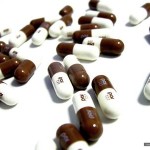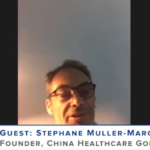Biotechnology and the Genetics Industry — pushing forward Chinese technology for good or evil? | Daxue Consuling
Biotechnology and the genetics industry in China.
Last year, a Chinese researcher, Jiankui He, was reported to presumptuously conducted a genetic modification experiment on two children of HIV infected parents. This experiment (CRISPR Cas-9 targeting/editing of HIV-related genes) received a wide range of attention not only from scientists but also the general public. Even though the scientific community is criticizing He from the bioethical perspective, this incident can still be regarded as an opportunity to focus more on the fast-developing biomedical and genetic engineering field and invest more resources into biological research.
There many applications of genetic engineering technology in our daily life, including agriculture, farming, food and beverage, pharmacy, energy production, and mechanical development. For example, in agriculture, by editing specific genes within the crop’s DNA, farmers can have higher productivity and the crops also become more nutritious.
Genetic-related markets are expanding globally and domestically
As Market Research Future forecasted, the global market for genetic engineering is expected to grow at a CAGR of approximately 14.5% during 2018 and 2027. ‘Genetic’ is an umbrella word that covers numerous segmented niche markets, including genetic testing, genetic sequencing, gene therapy, and precision medicine. All these areas are showing growth with advanced biomedical technology and higher resource investment, especially the categories: genetic testing and genetic sequencing.
The global genetic testing market
Genetic testing extracts DNA information from the applicant’s body and analyzes the genotypes to verify the effectiveness of genotype expressions. This technology can diagnose existing diseases as well as detect potential risks of getting gene-related diseases. As shown in the chart below, this technology is currently widely applied in oncology, life science, and genetic health. Within these three areas, oncology and genetic health occupy 80% of the total market. Most noticeably, due to the increasing number of cancer patients, the demand for genetic testing has boomed. As shown in the chart below, the global market size for genetic testing raised to 11.7 billion dollars, which was a 98.3% increase compared to 2015. Therefore, given the higher demand for this specific market and the immersive potential of new technological development, we can assume that this growth will continue during 2019.
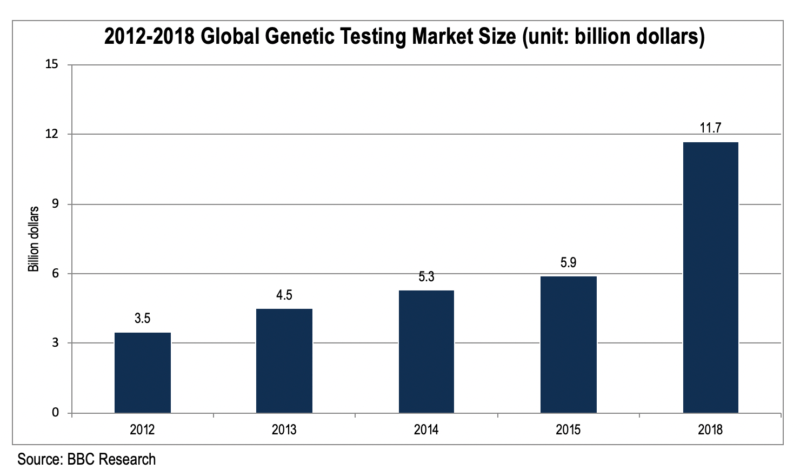
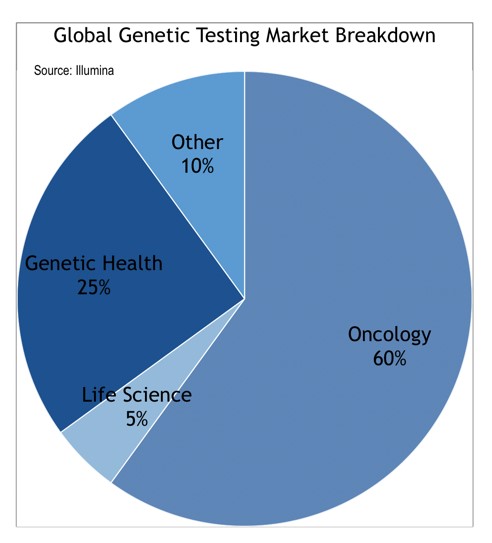
China’s genetic testing market
A similar trend also appears in the Chinese genetic testing market. As shown in the chart below, from 2014 to 2018, the Chinese genetic testing market boomed from 2014 to 2015, which had a growth rate of 52.5%. The rate kept steady between 2016 to 2017 (25.5% and 23.4%) and increased in 2018 (31.0%). In addition, such a growth trend corresponds with the number of new genetic testing companies established in China. As shown in the chart below, 2015 is also a year where more genetic testing firms were established; such a coincidence indicates that the primary promoter for the Chinese genetic testing industry is the number of related firms. Even though these firms were the new entrants for the industry, they are developing quickly by taking advantages from the overall development of the industry and become the major pushing forces. Therefore, compared to the global market, we can assume that the Chinese genetic testing market is sound and thriving.
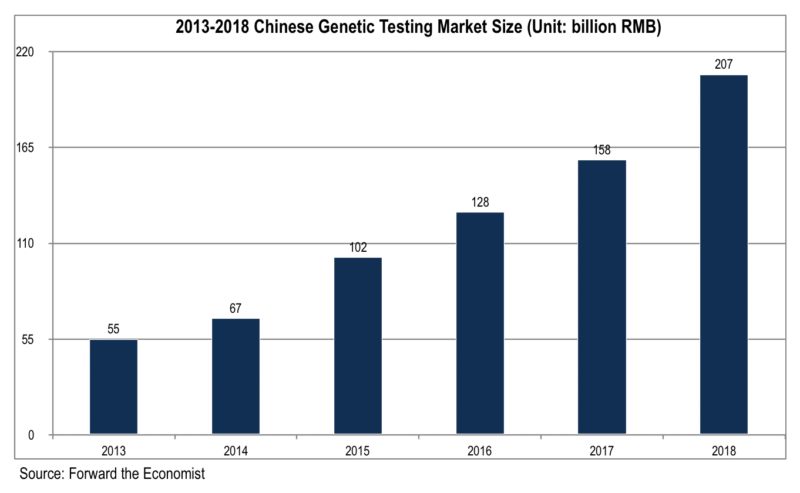

China’s genetic sequencing market
Since 2012, the Chinese genetic sequencing market is also consistently growing. The expected market size for genetic sequencing will expand to 30 billion RMB in 2022, with a growth rate of 35%. As shown in the chart below, due to the loosed policy and the government’s intended encouragement of genetic sequencing technology development, the growth rate of this niche market demonstrates a more than 60% growth rate between 2015 and 2016 and this tendency maintained until 2018.
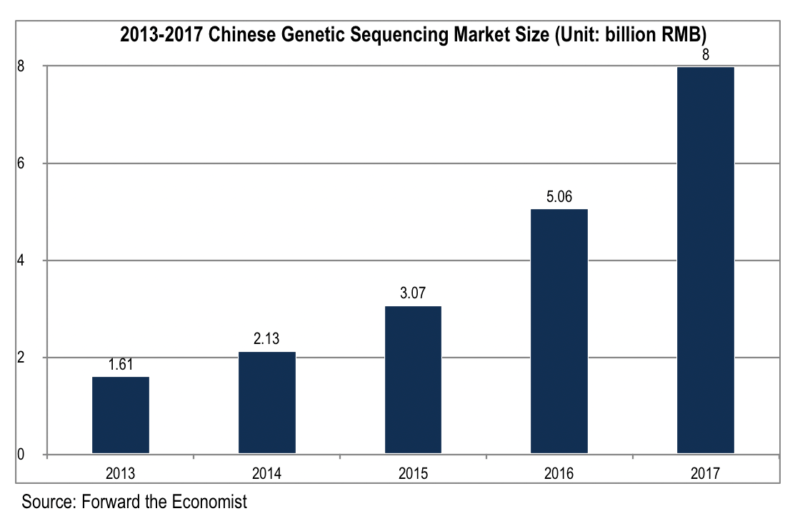
Genetic sequencing has lots of applications, including tumor diagnosis and therapy, medical research and development, inherited diseases diagnosis and embryonic selection and implantation. All of these small segments are unsaturated, and there is a significant potential for the market to grow into a market size of several billion.
Essential chemical and mechanical market in China
The basic Chinese chemical and mechanical market are also thriving. For example, the biological-related market is expected to reach 1000 billion RMB by 2022. Since 2011, the bio-based materials are occupying more market share; more and more biological chemicals are substituting the traditional chemicals, and the sales revenue on bio-based material holds 10% of the total Chinese chemical market. Therefore, due to the accelerated development of this area, we assume that this trend will also preserve in the following years.
Are Chinese consumers familiar with this new tech?
Baidu Index demonstrates a steady growth in awareness of related genetic topics.
The genetic industry is a relatively unpopular industry in China compared to the consumer goods market or other high-tech industries. According to the Baidu Index, the peak searching frequency of “genetics” in the Chinese Internet appeared when Jiankui He’s incidence was published. Therefore, typically the searching frequency remains consistently low which also signifies those specialized in this area are still interested, and there is no tendency for the market regression. Also, according to Baidu Index, there is a 27% increase of searching frequency within six months, which supports our assumption of the constant or slightly increase of consumer interest.

Baidu Index of the gene [Source: Daxue Consulting]
What questions are Chinese netizens asking about genetics?
Zhihu is a large Chinese question-and-answer website that provides Chinese netizens a platform to discuss their opinions on specific topics. As the Chinese genetic market is still in its first stage of development, there are some controversial aspects, like genetic testing and genetic sequencing.
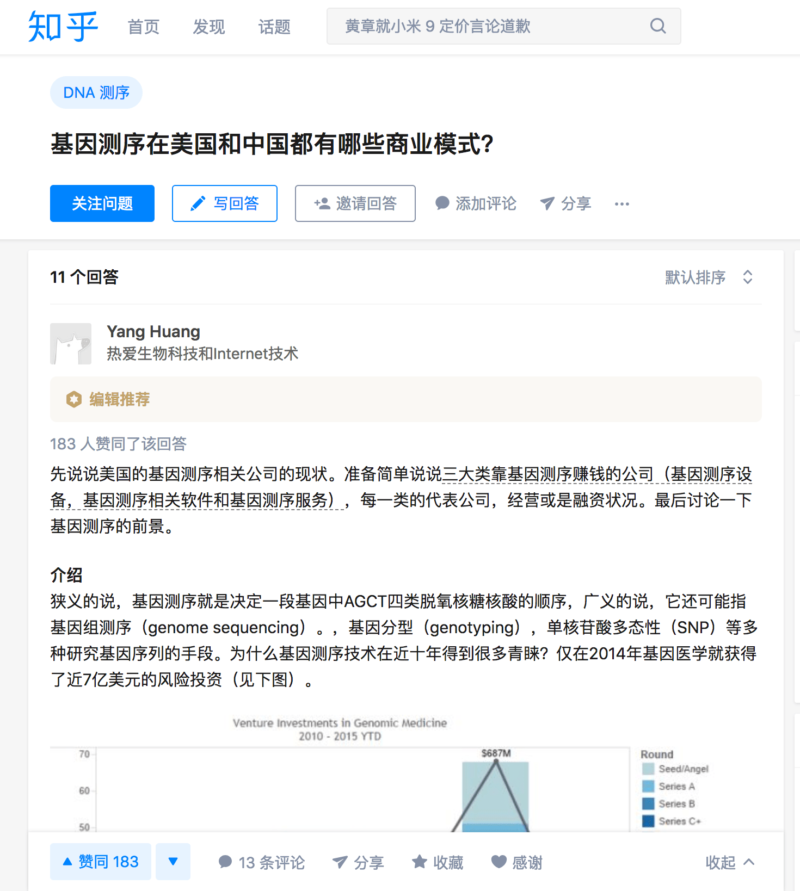
What are some business models of genetic sequencing in China and America? |
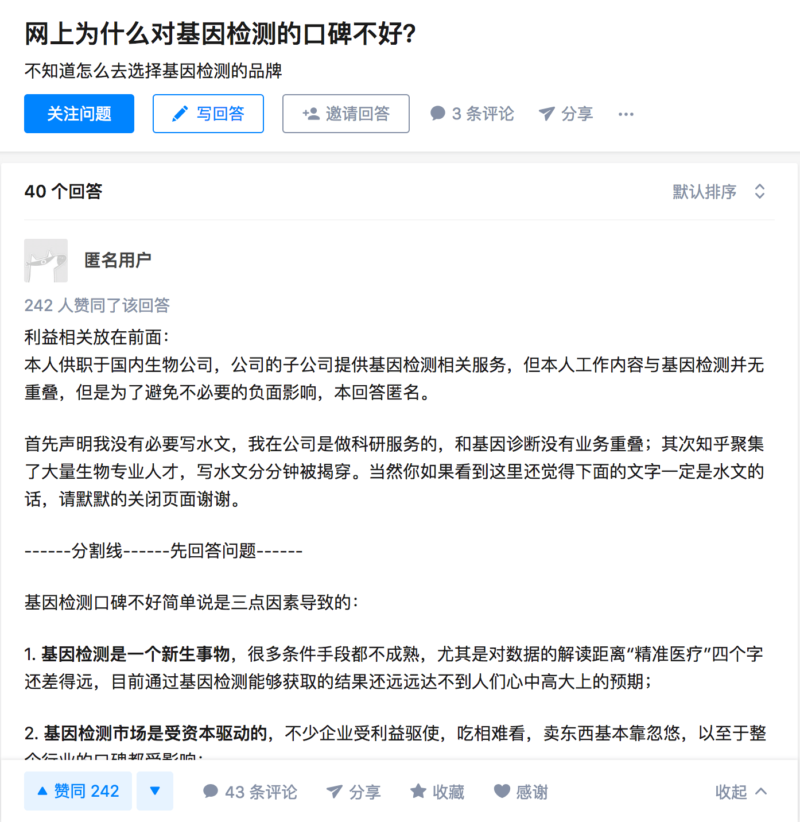
Why people are criticizing genetic testing? |
As shown in these screenshots, interested netizens are learning more about the business level of genetic sequencing and verifying the safety and effectiveness of genetic testing. The two answers received 183 and 242 “likes” on Zhihu. This means Chinese people are holding the passion of learning more on genetic and has accepting genetic knowledge in their everyday life, instead of only for the academic purpose.
CONTACT US NOW TO ANSWER YOUR QUESTIONS ABOUT BUSINESS IN CHINA
WeChat Official accounts discuss China’s bioethics
Compared to Zhihu, which has more information on genetic business in China, WeChat official accounts focus more on the moral and bioethical part of genetics. As shown in the screenshot below, the first article titled “genetically edited babies—innovation or demoralization?” received more than 11000 views; the second article titled “is genetics breakup the equity” receives more than 12000 views. Although this massive amount of views is mainly attributed to the highly-discussed genetic editing babies, it still allows the public to have a higher exposure to this topic and understand this industry better, especially when Jiankui He’s businessman identity was disclosed.
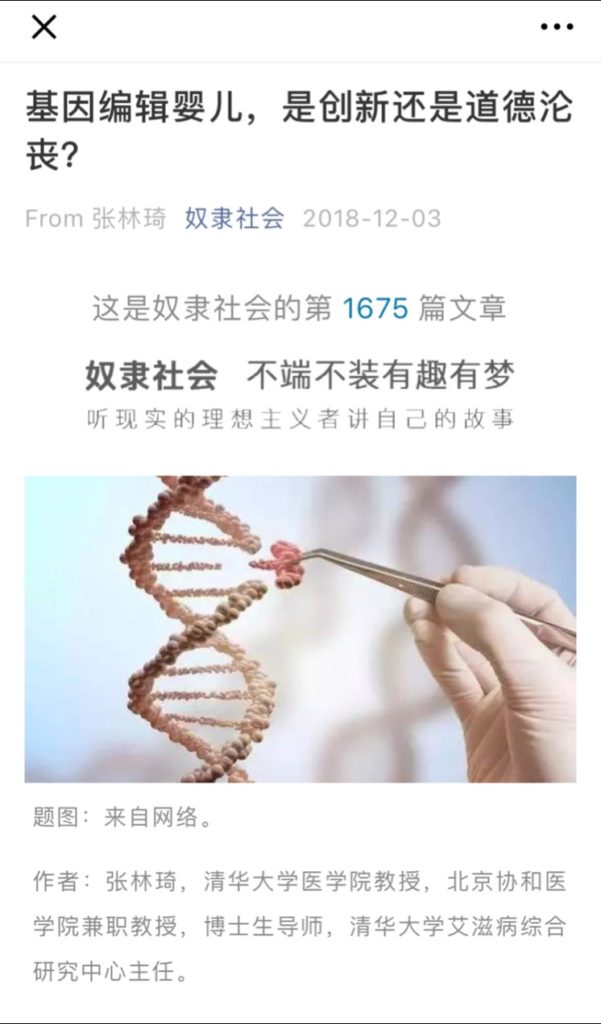
Genetically editing babies—innovation or demoralization? |
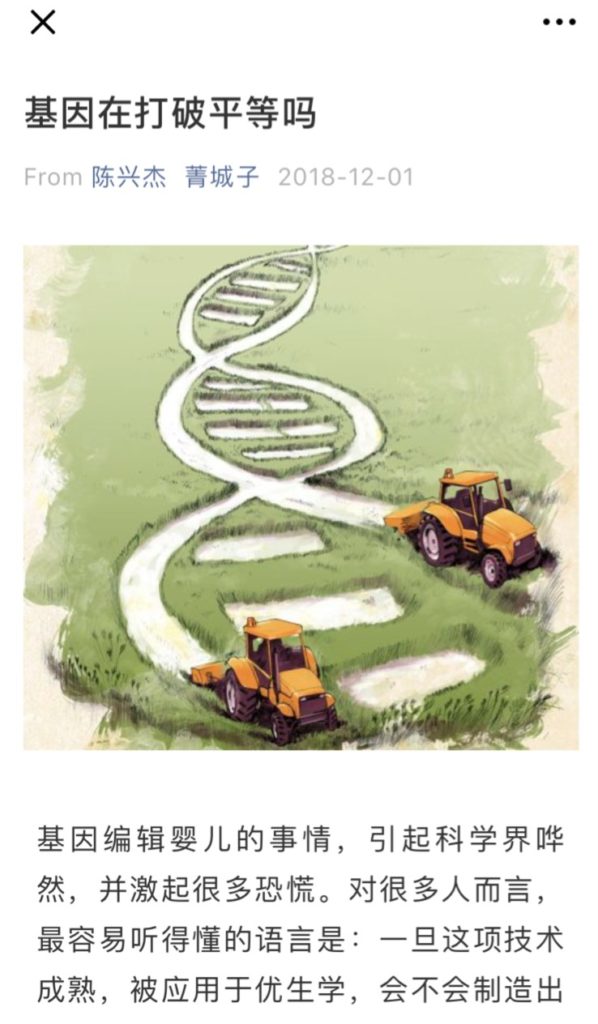
Is genetics breaking equality? |
Chinese netizens opinion on the transgenic industry
There are lots of discussions on the advantages and disadvantages of the transgenic industry. Even though transgenic technology has a broad application in our daily life, most of the researched netizens hold a negative attitude towards Genetically Modified Organisms (GMOs). 46.9% of the interviewed netizens disagree with creating transgenic food and only 19.6% support this application. Such a difference indicates that Chinese people are not confident about the quality of transgenic food because of the unverified harmfulness.

Compared to transgenic food, Chinese netizens have a higher acceptance rate on transgenic medicine. In this case, there are 40.9% of the interviewed netizens agree to apply the transgenic technology in developing more effective drugs, and there are 31.5% of them disagree with the practice.
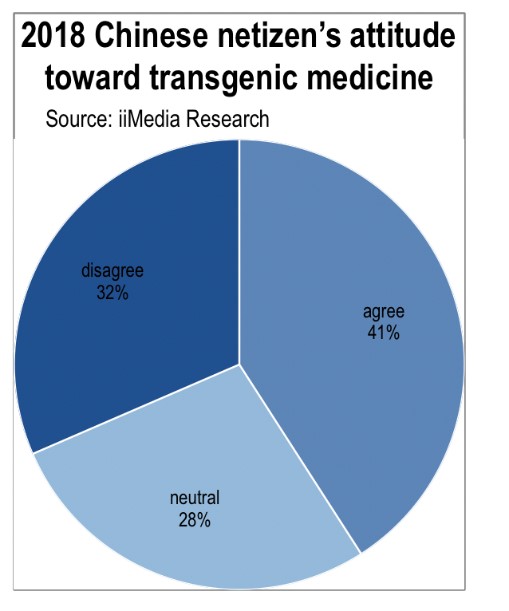
How are genetic products produced and delivered to consumers?
Genetic industrial chain in the global and Chinese market
The industrial genetic chain of genetic-related products consists of three parts: upstream suppliers, middle-stream service organizations and downstream customers. The upstream suppliers including the producers of experimental apparatus and equipment, like Thermo Fisher, Illumina, Roche and Oxford Nanopore. The middle organization consists of genetic testing and sequencing organization and biological information analysis organizations, which provide specific genomic-related services for the customers; the noticeable players in this area including BGI, Da An Gene, QIAGEN and Biomatter. The downstream customers including hospital, pharmaceutical companies, governmental research center, university research center, and specific individuals. These three parts interact together to form a dynamic industrial chain for the genetic market.

[Source: Daxue Consulting]
The most common distribution channels for genetic companies in China
Although the E-commerce platforms like Taobao, T-mall and JD are popular in China these days, the gene products are not commonly sold on E-commerce platforms. For example, there are several types of plasmid extraction kit displayed on Taobao with the labeled price from 118 CNY to 9216 CNY, the brands and the product types are incomplete, and the sales volume for all these displayed products is zero. On T-mall and JD, there were no search results when searching for genetic editing kits, which makes the E-commerce platforms unsuitable for delivering genetic products.
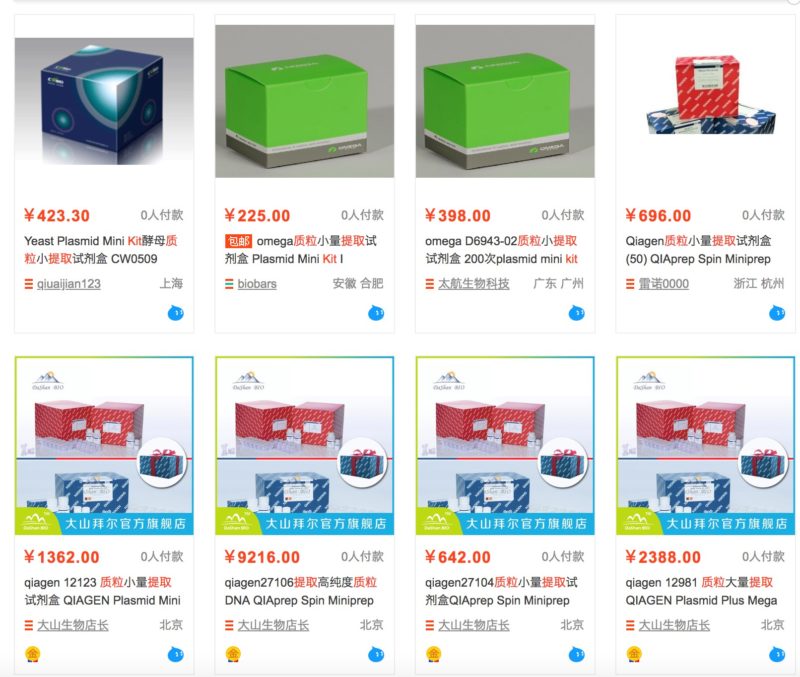
Plasmid extraction kit products display on Taobao, with 0 buyers
Research labs always expect high-quality genetic products to prevent the ruin of the experiment due to the experimental apparatus and reactants. According to an industrial insider in Shanghai, biological tests usually require precise experimental conditions and superior lab apparatus. Since the experiment duration is quite long and one minor error can blow the whole experiment and waste several months’ effort, experimenters are often willing to pay more for higher quality equipment and reagents. Therefore, we can assume that the price elasticity for lab researchers are quite inelastic. This also explains the lack of sales volumes on Taobao. As Taobao mainly targets on consumer goods, which are targeting the general public, the price and quality fluctuation between different sellers are ubiquitous. Moreover, for genetic products, Taobao seems too informal of a platform, and the quality promises that the sellers made is not safe enough for the researchers.
In comparison, the same industrial insider told us that common research centers would order genetic and experimental product on official brand websites. The genetic companies site usually have an apparent breakdown of the products they have, which allows the buyers to get what they want in one click. For example, TransGen, a well-known domestic biotechnology company, provides all kinds of genetic and molecular biology reagents and apparatus. They have a comprehensive numbering system on the products, and the customers can quickly type in what they want and order the product effectively.
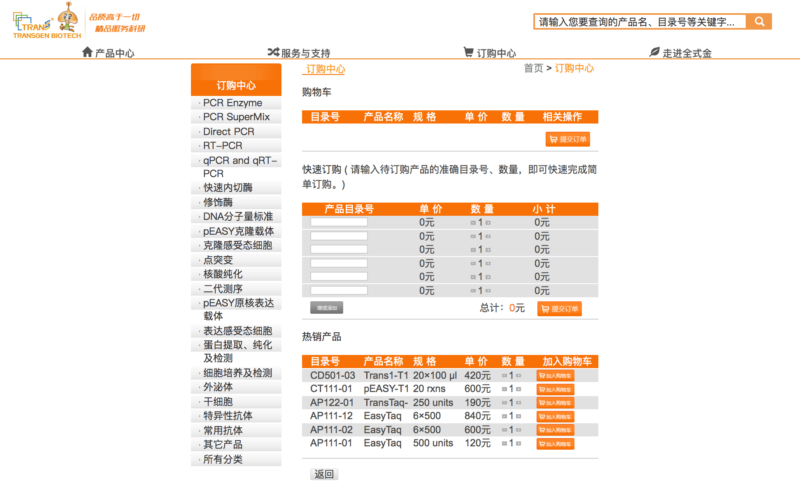
TransGen official website homepage
The biotechnology industry in China: Learn from the leaders
One of the characteristics of Chinese biotech companies is that they are often small but develop fast. However, some companies have become the symbol of this industry and thrive even in such vigorous competition, including BGI and DAAN Gene from the domestic sector as well as Qiagen and Thermo Fisher as international competitors.
BGI—the most significant Chinese genetic sequencing company
BGI was established in 1999 and was formerly named Beijing Genomics Institute. It is the most significant genetic sequencing company in China and worldwide. The service of BGI covers all three stages of the industrial chain. Besides sequencing services, they also produce experimental types of equipment like sample preparation machine and ultrasound diagnosis equipment, in addition to the sequencing machines. Their experimental kits products cover DNA, mRNA, rRNA, protein experiments but are not emphasizing on PCR or plasmid extraction kits, which means BGI focuses more on providing one-stop services for their customers but not providing those consuming reagents.
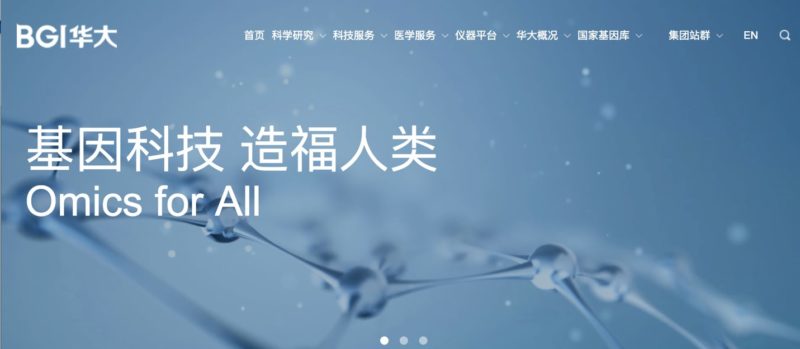
BGI official website homepage
Besides these reagents and experimental apparatus, BGI also has comprehensive biomedical services focusing on pregnancy, inheritance, cancer diagnosis and other detecting services, including drug-detecting and consanguinity determination.
BGI has a positive reputation not only in their specialized area but it also involved in national research, including Human Genome Project, HapMap Project, and Yanhuang Project. These significant research project helps the company to build up its reputation and creates a positive brand image. As the primary customer of BGI is research centers and hospitals, these public projects also increase BGI’s customer awareness in the first stage.
DAAN Gene—noticeable Chinese market player
DAAN Gene was formed in 1988 and was built by combining the other two biotech companies. Their products also cover equipment and consuming reagents. Comparing to BGI, DAAN provides more small-scale equipment like Real-time PCR Machine and DNA extraction machine. They also offer medically related PCR kits and focusing on fluorescence products, which is a small segment in the genetic experiment reagent market.
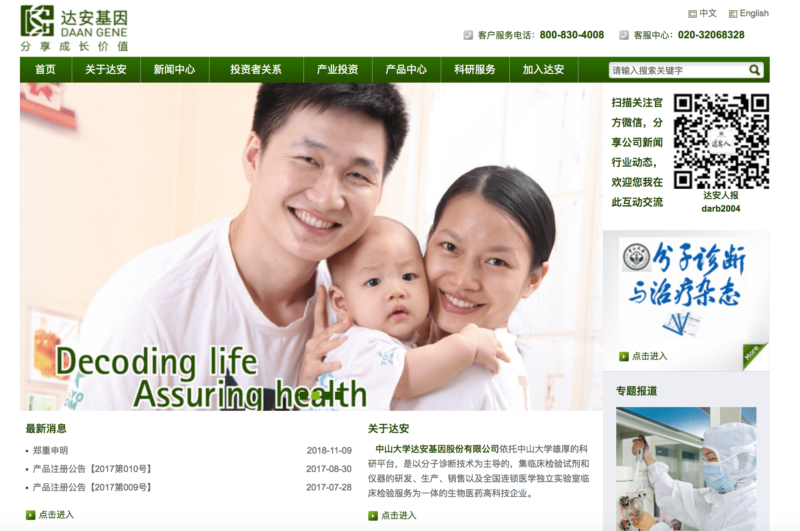
DAAN official website homepage
DAAN Gene is a publicly trading company, which also forces the company to maintain a positive image in front of the investors. There are specific sections that conclude DAAN’s recent media exposure and also two parts (investor relationships and product investment) that attempt to attract more investors and back up the company’s development.
Qiagen—well-known German biotech company in the Chinese market
Qiagen is a biotech company established in 1984, headquartered in Germany. Qiagen’s products including consuming reagents and experimental kits as well as testing and sequencing services. Unlike the two domestic brands mentioned, Qiagen’s homepage directly provides product online ordering service, and consumers even do not have to search for specific products on other website branches. For the new consumers, there are clear instructions above the ordering area. The website also allows the buyers to upload Excel directly, so they do not need to type in the catalog numbers. This feature can be very convenient for returning customers and increase the efficiency of the ordering process and reduce the possible ordering mistake.
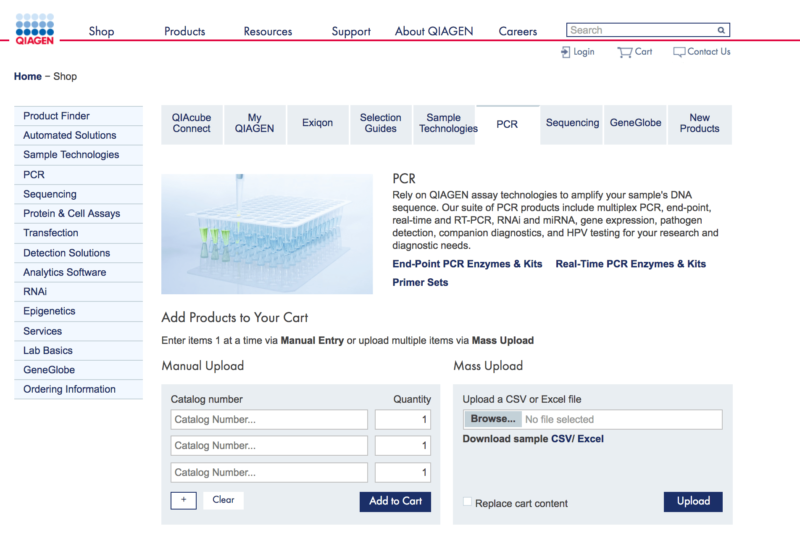
Qiagen official website homepage
Thermo Fisher Scientific— with a focus on experimental equipment
Thermos Fisher is an American biotech company formed via the merger of Thermo Electron and Fisher Scientific. This company focuses more on lab instruments and equipment but also has lab supplies and consuming reagents, including cell cultures and transfection reagents, DNA and RNA purification kits and qPCR assays, Master Mixes and Primer/Probe Sets and RNAi. Unlike Qiagen, Thermo Fisher does not involve in too much of research project and mainly focus on product research and development.
The homepage of Thermo Fisher’s official website does not direct the viewers directly to the ordering process; most of the homepage spaces are distributed to the product introduction. There is a small area at the top of the homepage that can still allow the consumers to order what they want quickly.
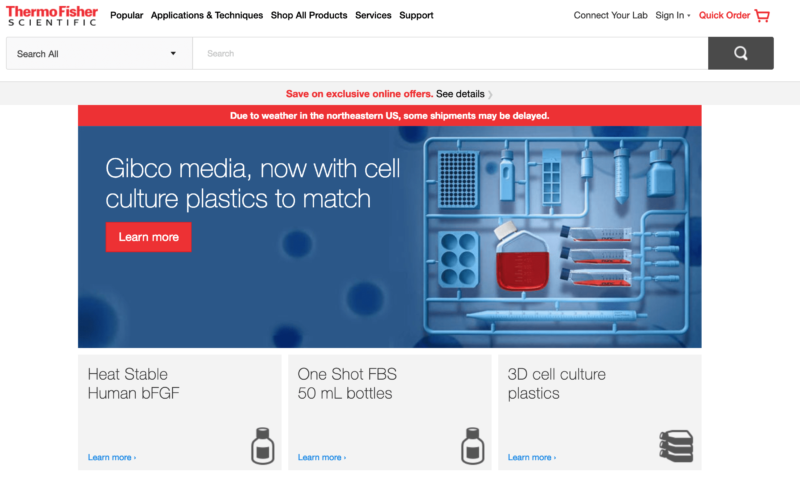
Thermo Fisher official website homepage
Based on all the above, for the recognized biotech companies, the product types are comprehensive, and the consumers can generally obtain the whole sequence of services they are looking for in the same brand. However, the brands do have their focus as are more reputable in a small segment of the genetic market. As for the Chinese genetic market, the consumers, especially biological researchers, are searching for the brands and products that are the most high-quality and leads to the least experimental failure. Therefore, some of the researchers are trying out the products from different companies and select the most useful ones.
How to break into the Chinese genetic market
As a fast-developing industry, more marketing strategies are still discovering for biotech companies. There are three standard methods for a genetic company to enter the Chinese market, including sending business development representative to the research lab to introduce the products to the experimenters, sending free samples to the lab and promoting in a large-scale academic conference.
How to promote your biotechnology company in the Chinese market among the target audience?
Business development representative as a significant marketing force
For domestic biotech companies, sending product salesman to the research lab can be the most effective way to increase customer exposure. According to another industrial insider, there are about three to four business representatives to visit his lab per week on average. Most of them will directly talk to the Principal Investigator of the lab and left a company booklet with some free samples for the lab.

Common biotech company booklet [Source: http://www.sheji.sh.cn/news-id4-210.htm]
This is an effective way to create the shortest path from the producer to the customer, but the lab experimenters tend to stick with their original supplies and will only use the free sample when they run out of their reagent stock. Therefore, the quality of the product is essential. Since biological and molecular experiments have a high requirement for experiment condition and are highly time-consuming if the free samples cause any experimental failure, even that is not the problem with the product; the lab will restrict this brand.
Sending free samples to the lab
Some biotech companies with middle to large size will sometimes send their new product as a free sample to their original consumers. As the customers already recognize the brand and have an impression of the brand quality, the chance they will try the new product is relatively high. This can be a useful strategy in terms of raise the sales volume for the new product. However, if the new product is a substitute for the original product, it is possible that the cannibalization of the new product to the old product will be significant and the company will need to evaluate the overall revenue structure to maintain healthy cash flow.
Promoting in a large-scale academic conference
Conferences and meetings are a large portion of biological research, and the principal lab investigators usually will be invited to the massive biological conference. This can be an excellent opportunity for biotech companies to promote their products and increase their brand awareness. The biotech companies can set up experience and product information stations in the free space. During the conference break and free time, the principal investigators can easily access the information stage and have some knowledge about the brand, which can be incredibly useful for further business development.
In conclusion, the Chinese genetic industry is developing rapidly, with the help of loose government policies and more financial support, now is the time to break into the Chinese genetic market. For the start-up biotech companies, tailoring the product is crucial for the company to success. For the well-known international competitors, with ensured product variety and quality, it is essential to choose the quality and to utilize efficient strategy to enter the Chinese market and occupy more market share.
Author: Xiangyu (Lavender) Mao
Daxue Consulting helps you get the best of the Chinese market
Do not hesitate to reach out to our project managers at dx@daxueconsulting.com to get all answers to your questions.



